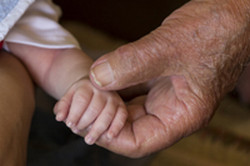Calculating one's biological age
Genetic heterogeneity as well as environmental factors influence the rate of human ageing. To measure the true biological age of an individual and predict the onset of diseases, identifying age-related changes that serve as biomarkers is necessary. Although many candidate biomarkers have been proposed, no single measurement has proven useful. This could be due to the multi-system nature of ageing which requires multiple parameters to be analysed at once. In this context, the EU-funded 'European study to establish biomarkers of human ageing' MARK-AGE study proposed to identify a set of biomarkers of ageing to measure biological age accurately. To achieve this, MARK-AGE partners performed a large study of over 2 300 individuals of different ages from seven locations across Europe. Another study group contained subjects born from a long-living parent belonging to a family with long-living siblings. All enrolled subjects provided anthropometric, clinical and social information. Physical examination included measurements such as body mass index, waist and hip circumference as well as blood pressure and heart rate. In addition, subjects donated peripheral blood for further genetic and immunophenytoping analysis. A series of putative DNA-based markers were examined such as DNA methylation, DNA repair and chromosome length. At the protein level, researchers looked at certain protein modifications and signs of protein damage. Since immune responses diminish with ageing, a number of immunological parameters were also evaluated such as antibody and cytokine levels. The study additionally included assays for measuring markers of metabolism and oxidative stress. Out of these biomarkers, ten were selected based on their ability to better correlate the biological with the chronological age in the population. The results of assaying for these biomarkers were subsequently used to calculate a score that served as a prediction of an individual's biological age. The long-term goal of the MARK-AGE study was to develop a mathematical model that could calculate one's biological age utilising these 10 biomarkers. This could help develop novel strategies for preventing accelerated ageing for a healthier lifestyle.



